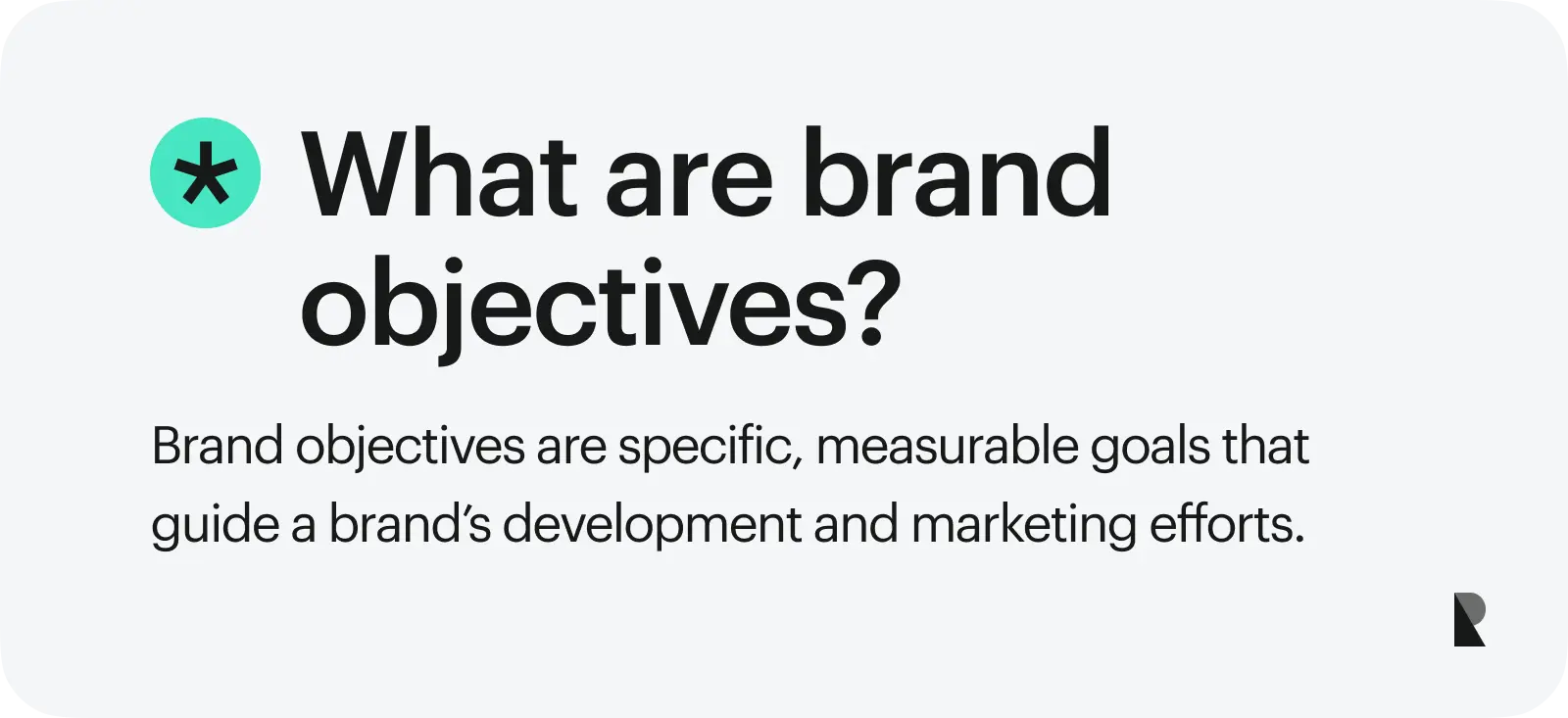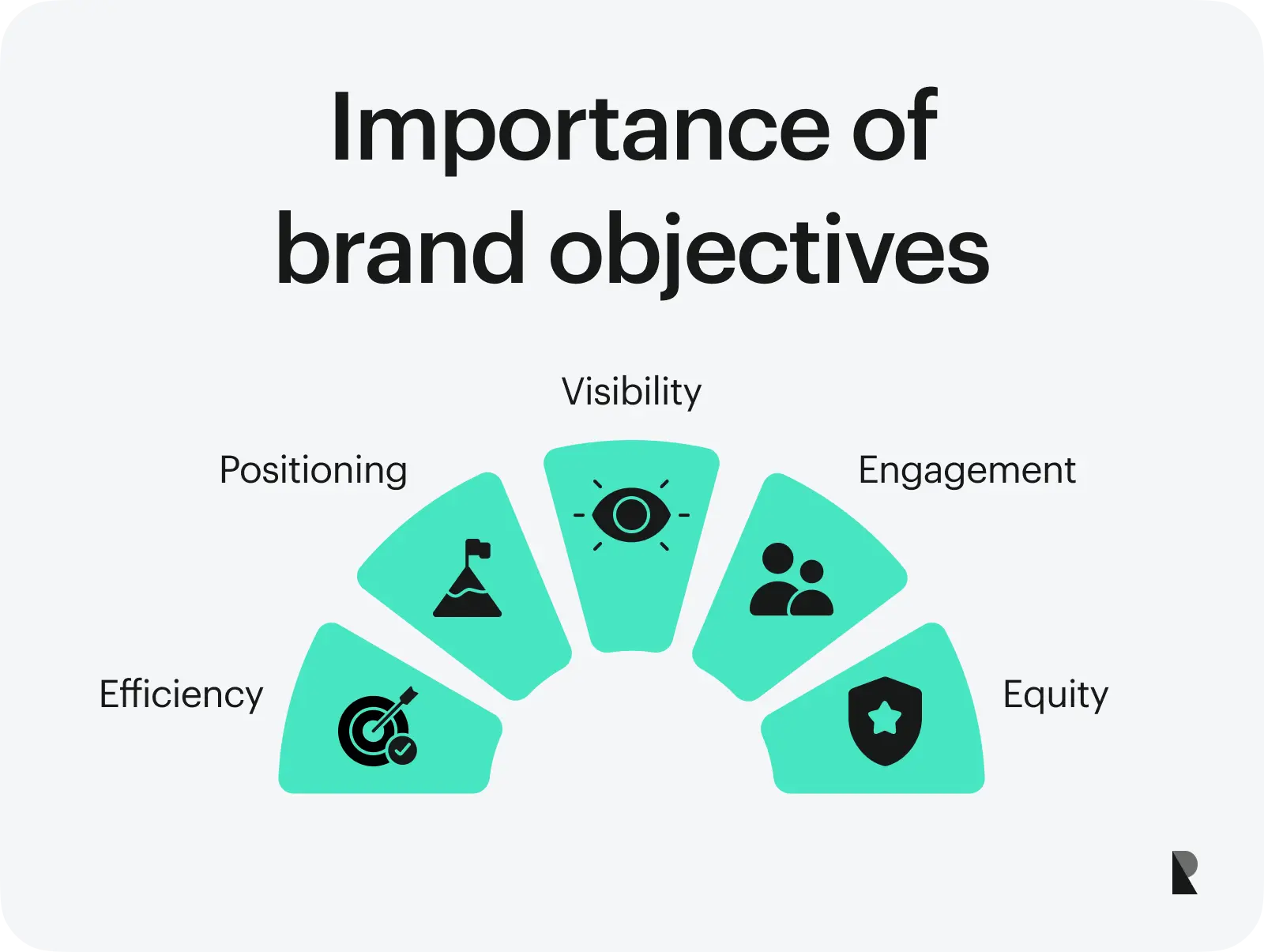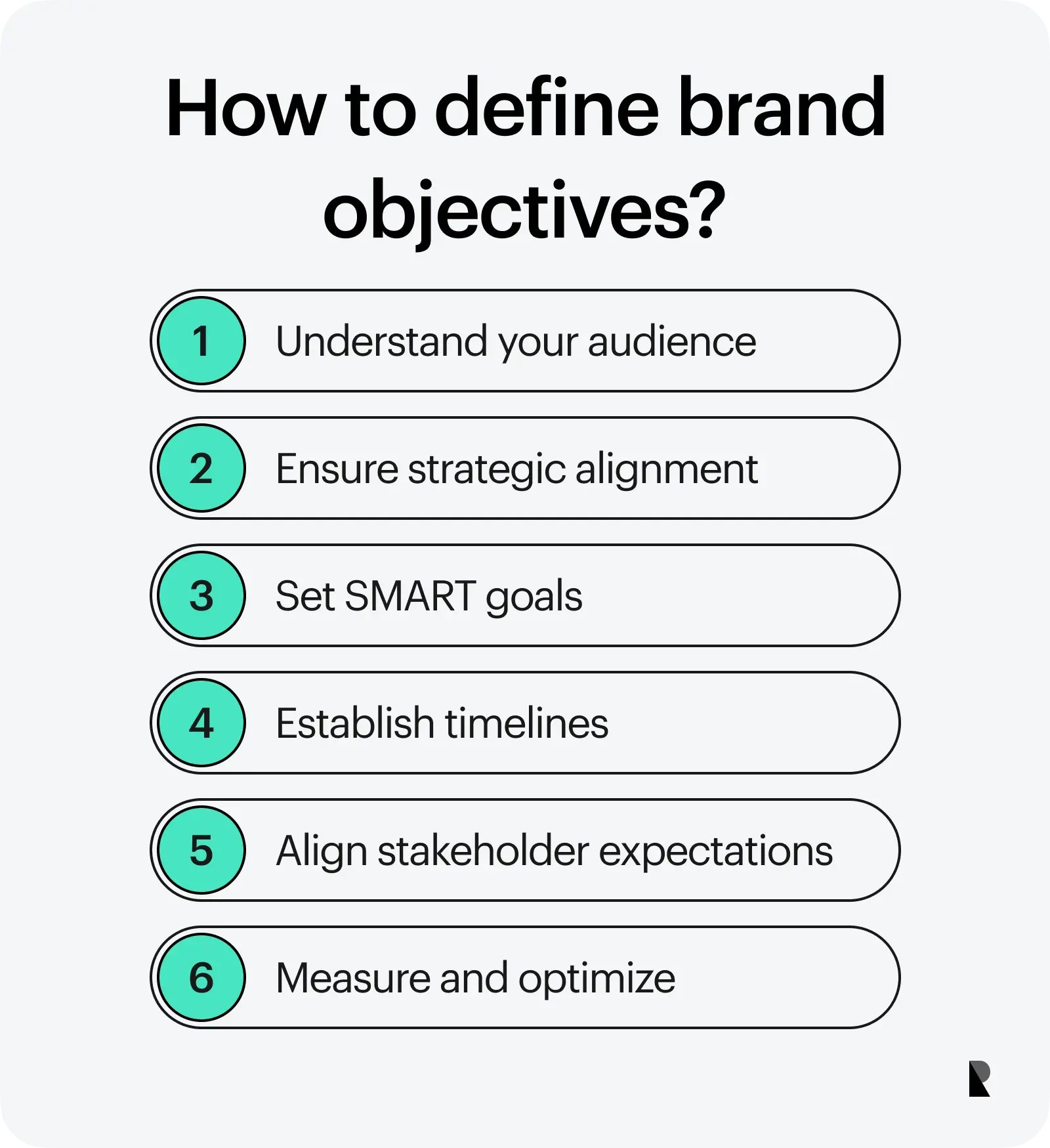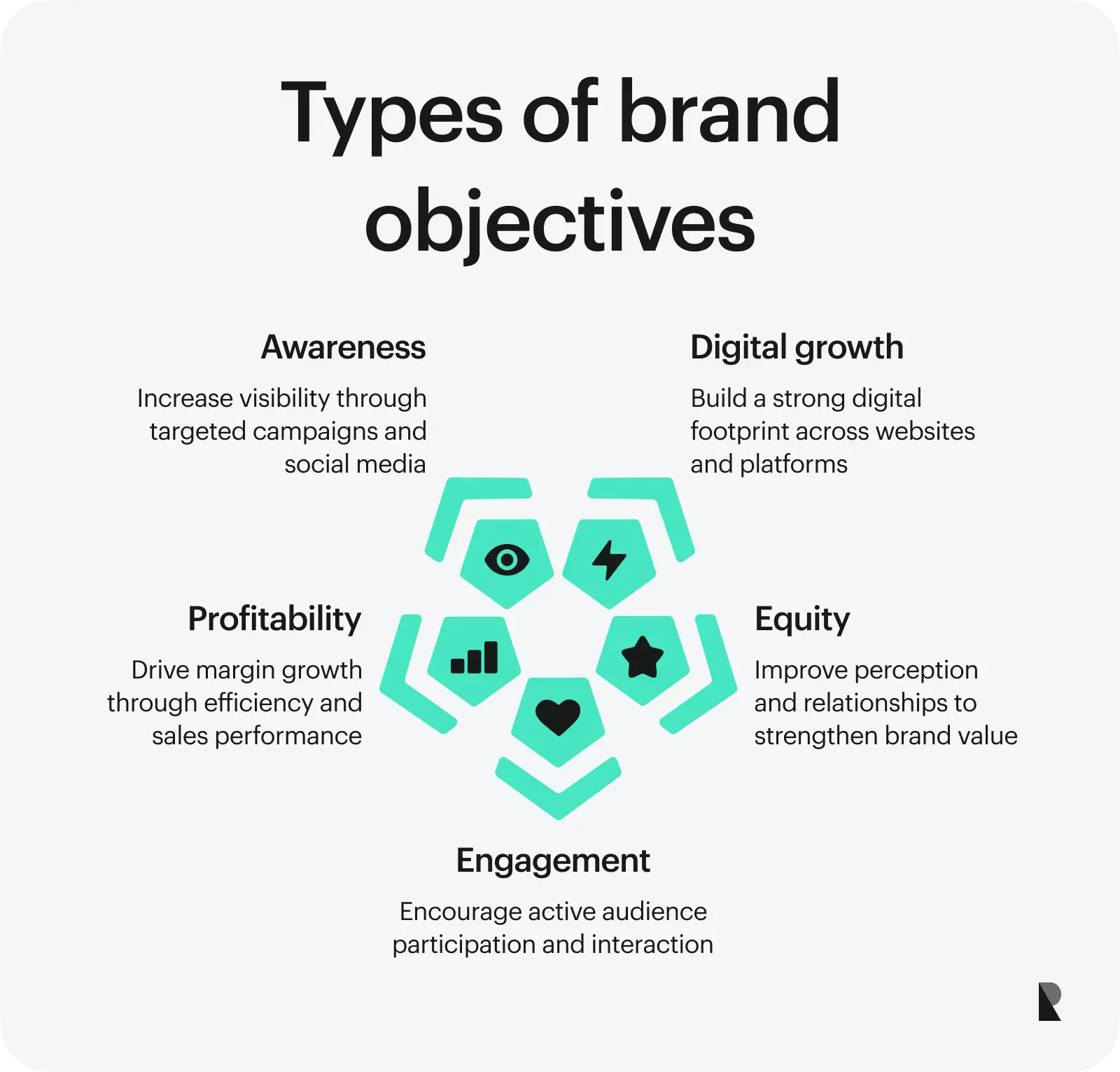Introduction

To excel in your branding efforts, you need to have clear-cut goals. Only companies with distinct brand objectives can create a compelling branding, foster customer loyalty, and achieve long-term growth. So, let’s explore the importance of brand objectives, discuss a few different types, and learn how to define and implement them effectively to boost brand awareness, engagement, and equity.
Practical brand objectives are measurable, achievable, and well-aligned with your company goals. As 82% of consumers make buying decisions with a brand’s purpose in mind, the importance of communicating targets and ambition is evident. Brand objectives are not just about design principles; they help tie your entire brand strategy together, allowing you to build a brand that resonates with your audience.
If you want those objectives to live beyond the slide deck, partner with a brand identity design agency that turns them into a consistent brand experience across every touchpoint.
Why Are Brand Objectives Important?
Brand objectives are crucial to a successful branding strategy. They help provide a clear direction for all brand activities, ensuring consistency and focus.

- They Enhance Marketing Effectiveness: With clear objectives, a business can improve focus throughout marketing campaigns and build a machinery that resonates with your audience. Campaigns like these (value-aligned) are also much more likely to succeed since they are based on well-defined messaging goals that speak the language of your consumers.
- They Strengthen Your Market Position: Well-defined objectives help differentiate your brand from competitors, building a unique market space. This differentiation is vital, especially in crowded markets where consumers have multiple choices. Even with just two quality options, a strong brand identity can make a single difference when attracting new (and even retaining old) customers.
- They Boost Brand Awareness: Objectives focused on visibility increase the likelihood of customers recognizing and remembering your brand. Brand awareness is the first step in the customer journey, after all. And high brand awareness means that people know your brand, which leads to increased trust and preference.
- They Drive Customer Engagement: Engaging brand objectives create deeper connections with customers, turning them into brand advocates. An increase in brand engagement means additional meaningful touchpoints with customers through social media, email marketing, and events.
- They Improve Brand Equity: Consistent brand objectives fortify the perceived value of your brand, building customer trust and loyalty. Brand equity is the value that your brand adds to your product or service; it is essentially drawn from what consumers think, feel, and act about your brand.
6 Steps for Defining Brand Objectives
The best process for defining clear and compelling brand objectives is to do it in multiple steps. Here’s a 6-step guide to help you get started.

1. Know Your Audience
Understanding your target audience is the most important part of setting relevant brand objectives. Start by conducting thorough market research to collect data on customer preferences, behaviors, and demographics. This will ensure that your objectives also align with what your audience values most, resulting in an optimized presentation of your brand attributes.
Try using surveys, focus groups, and social media listening tools to get to know your audience. These can help you gather insights into your customers' needs, preferences, and pain points. You can also analyze your existing customer data to identify trends and patterns that can help inform your brand objectives.
2. Align with Marketing Strategy
Your brand objectives should always harmonize with your marketing strategy. Eighty percent of marketers feel like their industry has changed more in the last three years than in the 50 years before it. With this segment changing so rapidly, alignment is absolutely crucial to ensure that your efforts all work towards the same goals, creating a cohesive brand message across all your touchpoints.
For example, if your marketing strategy focuses purely on digital channels, your brand objectives should probably include goals around increasing your online presence and engagement. If your strategy heavily values customer experiences, your brand objectives could address customer satisfaction and loyalty.
3. Set Measurable Goals
Always set quantifiable goals and track your progress, success, and failures. So, instead of aiming to "increase brand awareness," set a target to "increase brand recognition by 20% within half a year." Measurable goals provide a better benchmark for evaluating your progress and allow you to make data-driven decisions now and in the future.
To set measurable goals, you can use the SMART criteria: Specific, Measurable, Achievable, Relevant, and Time-bound. This framework helps in keeping your goals clear and attainable.
4. Have Realistic Timelines
Make sure to have achievable timelines for your objectives. Unrealistic timelines are vital for frustration and burnout, while thoughtful timelines keep your team motivated and on track. Think about what you really need to do and the complexity of the objectives as you set timelines.
Launching a new product takes longer than increasing social media engagement. Consider breaking larger objectives into smaller, manageable tasks with specific deadlines. This will make tracking progress and staying focused on achieving your goals more straightforward.
5. Manage Expectations
By setting realistic goals, you can better manage expectations. Clear communication with stakeholders about what can be achieved also helps maintain a positive and productive environment. It's really important to balance ambition with practicality so that your objectives are challenging but actually doable.
Regularly update people on your progress and any potential challenges that pop up. This helps build trust and ensures that everyone is aligned with the brand objectives. Oh, and don’t forget to celebrate those small wins along the way, too.
6. Track and Analyze Results
Monitor and evaluate the effectiveness of your brand objectives at regular intervals. Use analytics tools to track visitors, average time spent on your website, and other metrics relevant to your goals.
If your objective is to increase brand awareness, for example, track metrics like website traffic, social media followers, and engagement rates. You should monitor customer retention rates, repeat purchase behavior, and customer feedback to improve brand loyalty.
Different Types of Brand Objectives (+ Frameworks)
There are tons of different brand objectives that you can set, each serving a different purpose and being effective in various ways for various industries. Try to figure out which works best for your overall business goals, and go all in on that first. To get started, here are some examples of objectives as well as a brief framework of how to achieve them:

Boost Brand Awareness
- Objective: Increase brand image and visibility through targeted ad campaigns and social media presence.
- Strategy: Use relevant (to your audience) advertising platforms to reach people and present advertisement content that helps connect them to your brand.
- Example: Building a comprehensive social media strategy with regular post cadence, influencer partnerships, and engaging content.
How to Boost Brand Awareness
| Choose the Right Paid Platform | Google Ads: Ideal for search-based advertising, helping to target people actively looking for related keywords — which is great if you’ve not yet gotten any traction in branded search. | Meta (Facebook, Instagram): This is perfect for visual and engagement-based ads where you can also leverage detailed demographic targeting, including age, interests, behaviors, and location. | TikTok: Excellent for reaching a somewhat younger audience with creative, short-form video content. Also TikTok's got a robust targeting option to help you engage with specific demographics. |
| Create Engaging, Branded Ad Content | Visuals: Always develop high-quality, eye-catching visuals that help represent your brand's identity and message at all times. | Messaging: Writing compelling ad copy that resonates with your target audience and includes a strong brand voice is key. | |
| Target Specific Demographics | Demographic Targeting: Try using the platforms’ targeting aspects to focus on specific age groups, genders, interests, and locations that reflect your brand’s audience | Behavioral Targeting: You can also target users based on their online behaviors and interests to increase ad relevance — this is especially interesting aligned with brand values. | |
| Track and Optimize Brand Performance | Analytics Tools: Utilize all the analytics tools you have at hand to monitor ad performance metrics such as click-through rates (CTR), conversion rates, and return on ad spend (ROAS). | A/B Testing: Make sure to conduct A/B testing on ad creatives as well as copy to see what works best, and continue to optimize your brand campaigns based on the findings. | |
| Collaborate with Influencers | Identify Influencers: Find influencers whose audience seems to align with your target market. Their followers should ideally have a genuine interest in your industry or, in a perfect world, even your product. | Create Authentic Content: Work with influencers to produce authentic, engaging content that promotes your brand. This can include sponsored posts, product reviews, and unboxing videos. It’s important to find influencers that really believe in your brand: your audience can smell ‘fake’ from miles away. | Measure Impact: Track the performance of influencer collaborations through metrics like engagement rates, new social followers, and referral traffic to your website. |
| Maintain a Regular Posting Schedule | Editorial Calendar: Create and maintain a content calendar to plan and schedule regular posts. Consistency keeps your brand top of mind here, and engages your audience over time. | Interactive Content: Use interactive elements like polls, Q&A sessions, and live streams to encourage audience participation and engagement. |
Grow Online Presence
- Objective: Build a digital footprint through the website(s) and online platforms.
- Strategy: Optimize your website for search engines (SEO), create engaging content, and leverage social media.
- Example: Developing a blog that offers valuable insights related to your industry, driving traffic to your website, and increasing your online presence.
How to Grow Your Brand Online
| Optimize Your Website for Search | SEO Best Practices: Do your keyword research, on-page optimization, and meta tags to better your website's visibility on Google. | Mobile-Friendly Design: Make sure your website is mobile-friendly as well as responsive. Sure, search engines prioritize mobile-optimized sites; but so does your audience. | Fast Load Times: Improve website load times by optimizing images, using efficient coding practices, and leveraging content delivery networks (CDNs). This all helps in giving your user a great experience when engaging with your brand. |
| Create High-Quality, Relevant Content | Content Strategy: Develop a content strategy that addresses your audience's needs and interests. Plan for a mix of blogs, videos, infographics, and podcasts. Whatever your audience is looking for, where they’re looking for it. | Keyword Integration: Sprinkle your content with relevant keywords naturally to improve search engine ranking without compromising on readability or expertise. | Value-Driven Content: Make sure your content provides value. This is the most important part of branded content. High-quality content is also a lot more likely to be shared and linked to, boosting your online presence. |
| Engage with Your Audience on Social Media | Regular Posting: Maintain a consistent posting schedule on platforms like Facebook, Instagram, Twitter, LinkedIn, and TikTok. Use your content calendar to plan and organize posts that will keep your audience engaged with your brand. | Respond to Comments: Actively respond to comments, messages, and mentions on social media to create a sense of community and build stronger relationships between you and your audience. | |
| Leverage Other Online Platforms | Guest Blogging: Write guest posts for reputable blogs and websites in your industry to try and reach a wider audience, and establish authority in your space. This is especially effective if you’re able to craft thought leadership. | Online Communities: Become part of online communities, forums, and groups where your target audience spends their time. Here, you can share valuable insights and contribute to discussions to cement your position. | Email Marketing: Build and maintain an email list to send regular newsletters and updates to your audience and/or prospects. Always personalize your emails to boost engagement and drive traffic to your website. |
Enhance Brand Equity
- Objective: Improve brand perception and customer relations in order to boost equity.
- Strategy: Build strong customer relationships through fantastic service and consistent brand messaging.
- Example: Creating a customer loyalty program that rewards repeat customers, ultimately increasing brand equity.
How to Enhance Brand Equity
| Build Strong, Positive Associations | Consistent Branding: Make sure that your brand's visual identity (logo, color scheme, typography) and messaging are always consistent across every channel, including your website, social media, and marketing materials. | Quality Products/Services: Communicate the fact that you offer high-quality products or services that meet or exceed customer expectations. Of course, you also need to deliver on that promise. | Emotional Connection: Create an emotional connection with your audience by sharing your brand's story and values. Use content that resonates with their experiences and aspirations on both a relatable and emotional level. |
| Provide Exceptional Customer Service | Responsive Support: Offer quick and helpful customer support across multiple channels such as phone, email, live chat, and social media. Fast responses to questions and issues improve customer satisfaction, and — in extension — brand loyalty. | Personalized Experience: Personalize interactions with customers by addressing them by name, remembering their preferences, and offering tailored recommendations whenever possible. You’re talking to a person after all, not a screen. | Proactive Engagement: Proactively reach out to customers with updates, tips, and special offers. Try to show appreciation through loyalty programs and personalized thank you messages. |
| Ensure Consistent Brand Messaging Across Touchpoints | Unified Voice and Tone: Document and uphold a consistent voice and tone in all communications. Whether it’s formal or casual, your brand's personality should be experienced in every piece of content. | Clear Brand Guidelines: Develop and implement clear brand guidelines that outline your brand's visual and verbal identity. All team members and partners need to both understand and adhere to these guidelines. | Regular Training: Train your teams on brand values and customer service standards in regular intervals to make sure they’re always up-to-date and able to deliver a consistent brand experience. |
Increase Engagement
- Objective: Make the audience an interactive and participating part of your brand.
- Strategy: Create fun and interactive content that helps customers engage with you through different marketing channels (e.g., social media).
- Example: Host live Q&A sessions, AMAs, or webinars that engage your audience.
How to Increase Brand Engagement
| Host In-Person Events | Workshops and Seminars: Organize workshops and seminars to share valuable information and engage directly with your audience. It doesn't always have to be about generating leads, but about retaining customers. | Product Launches: Host product launch events to create excitement and interact with customers firsthand. This is a great time to invite loyal customers and show you care. | Community Events: Participate in, or sponsor, local community events to build relationships and increase brand visibility where it matters most. |
| Go Live on Social Media | Live Q&A Sessions: Conduct live Q&A sessions on platforms like Instagram, Facebook, and YouTube to interact with your audience in real-time, answer questions, and provide insights. If it’s a founder, C-level, or similar, this can be a great trust builder. | Live Product Demos: Showcase your products in action with live demonstrations, highlighting their features and general benefits. | Behind-the-Scenes: Share behind-the-scenes content to give your audience a glimpse into your company’s culture, everyday life, and operations. This is also a great step towards improved employer branding |
| Develop Interactive Content | Polls: Create polls on social media and your website to gather opinions and feedback from your audience. Polls encourage participation and provide valuable insights into customer preferences. | Contests: Run contests and giveaways that require user participation, such as submitting photos, videos, or stories. Contests create excitement and encourage user-generated content — a gold mine in terms of brand advocacy and social proof. | |
| Encourage User-Generated Content | Hashtag Campaigns: Establish branded hashtags and encourage your audience to share their experiences using your products. You can then feature the best ones directly on your social media channels. | Customer Reviews: Ask customers to leave reviews and testimonials on sites like Capterra, G2, or Google. you can then highlight positive reviews on your website and on social media — or even bad ones if you’re brave enough. | Community Building: Foster a sense of community by engaging with user-generated content and acknowledging contributions from your audience. |
Improve Profitability
- Objective: Strengthen profit margins through operational effectiveness and sales growth.
- Strategy: Make operations more straightforward and resource-friendly and optimize marketing spending for higher ROI.
- Example: Setting up a new inventory management system to reduce costs and improve profitability.
How to Improve Profitability Through Branding
| Implement New Technologies | Project Management Tools: Use project management software like Trello, Asana, or Monday.com to streamline brand workflows, improve team collaboration, and enhance productivity. | Brand Management Software: Invest in brand management tools that help maintain consistency in branding across all channels, automate routine tasks, and improve efficiency. | |
| Revisit Performance Marketing | Targeted Campaigns: Always make sure your performance marketing campaigns are targeting the right audience with the appropriate content and message. Your brand objective here is all about getting the right message to the right person. | A/B Testing: Conduct A/B testing on ad creatives, landing pages, and email campaigns to see what works best with your audience and improves conversion rates. | ROI Analysis: Check in on the return on investment (ROI) of your marketing campaigns and shift budget allocation to high-performing campaigns and optimize or cancel low performers |
Next Steps
Whether it's about increasing brand recognition, launching new products, or improving profitability, well-defined brand objectives are essential in guiding a business's branding efforts and achieving long-term success. When you truly understand your audience, have aligned your marketing strategy, and set measurable goals, you can start creating powerful brand objectives to drive growth and strengthen your brand's position in the market.
If you’re able to follow some of the guidelines and examples we’ve covered in this article, you’ll be able to set and achieve brand objectives that will build you lasting brand equity and loyalty. You could either start by hiring a professional to help you move the dial on your brand objectives, or you can find a brand strategy company that can guide you through the entire process — ensuring your brand is the best it can be. Whatever your next steps might be, we’re always happy to help.
Sep 24, 2024
